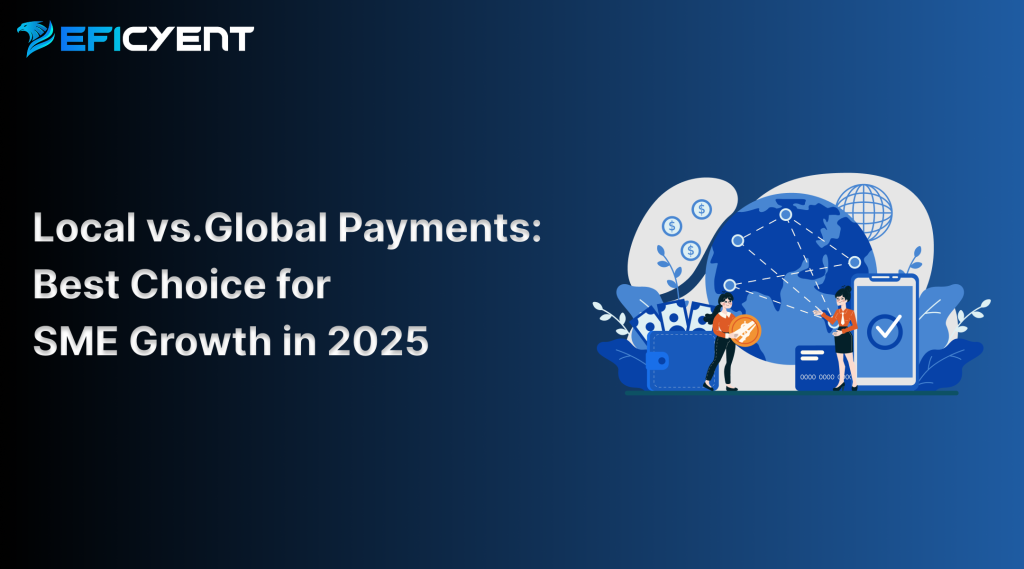
Small and Medium Enterprises (SMEs) are growing fast and technology is making it easier than ever.
A small business in one country can now sell its products to a customer sitting in Canada with just a few clicks. But with this growth comes an important question.
Should SMEs stick to local payments or go global?
The payment system they choose can affect cash flow, transaction fees and even customer experience. So, what is the smarter move in 2025?
In this blog, we will break it down in simple terms to help you choose the best method, whether it is local or global payments that can benefit the Small and Medium Enterprises growth in 2025.
Understanding Local and Global Payments
Before we dive into which option is better, let us first understand what each one actually means.
- Local Payments: Transactions happen within the same country using domestic payment methods like UPI in India, SEPA in Europe or ACH in the US.
- Global Payments: Transactions that involve cross-border payments, using international networks like SWIFT, PayPal, Stripe or cryptocurrencies.
Both have their advantages, but which one is the right choice for SME growth? Let’s explore.
Why Do Local Payments Matter?
Many SMEs begin with local payments because they are familiar, cost-effective and easy to manage.
Here are some reasons why local payments can be a good choice:
· Lower Transaction Fees
Local payment systems usually have lower processing fees compared to international payment gateways. For instance, UPI transactions in India are free or have minimal charges, making them ideal for small businesses within profit margins.
· Faster Processing Times
Domestic transactions clear transactions faster, sometimes instantly. This improves the cash flow, which is critical for you in managing tight budgets.
· Compliance and Security
Every country has its own financial regulations. Sticking to local payments means you don’t have to worry about compliance issues related to foreign currencies or banking regulations, which is an added benefit.
· Better Customer Experience
Local customers prefer familiar payment methods. If a business in India only accepts international credit cards, many local customers may hesitate to buy due to the unfamiliarity or high conversion fees they charge.
· Reduced Risk of Fraud
Global payments can be more vulnerable to fraud due to multiple intermediaries. Local payments often have stricter banking regulations which reduce the fraud risks.
Why Do Global Payments Matter?
Expanding beyond borders means dealing with different currencies and financial regulations. Here’s why global payments can be a turning point for SMEs.
· Access to International Markets
For small and medium businesses looking to expand, accepting global payments is a must. It allows businesses to reach customers worldwide without limiting their sales to local buyers.
· Multiple Currency Support
Global money transfers help businesses deal in multiple currencies, making it easier for international customers to pay without worrying about exchange rates.
· Higher Revenue Potential
With access to international buyers, SMEs can increase their revenue potential. A company in India selling handmade crafts can earn significantly more by selling to customers in the US or Europe.
· Better Financial Management Tools
Most global payment platforms offer analytics and automation tools that help SMEs track international transactions, manage taxes and also handle multiple currencies efficiently.
· Global Partnerships and Expansion
Accepting global payments allows SMEs to collaborate with international suppliers, freelancers and service providers, making expansion smoother.
But with all these benefits comes the setbacks as well for SMEs. Here are some of the main challenges of global payments:
- High Transaction Costs: International payment gateways charge higher processing fees, sometimes cutting off your profits.
- Exchange Rate Fluctuations: Currency exchange rates constantly change, which can affect the revenue. An SME that receives payments in USD but operates in INR might see a dip in earnings due to currency depreciation.
- Regulatory Compliance Issues: Each country has its own financial regulations, taxes and compliance requirements.
- Delayed Transactions: Unlike local payments, global transactions can take days to process, affecting cash flow and business operations.
Which Payment System is Best for SMEs in 2025?
The answer to this question depends on the business’s goals and market strategy. Here’s a simple way to decide which payment gateway is best:
- If the business is primarily local, then stick to local payments for lower costs, faster processing and better customer experience.
- If the business plans to expand internationally, then implement global payments to reach more customers and increase the revenue.
- There is one more way which is hybrid approach as many SMEs use both. They offer local payments for domestic customers and global payment options for international buyers.
Smart Payment Strategies for SME Growth
No matter what option you select, consider these tips for smoother payment processing.
- Use payment gateways that support both local and global transactions like PayPal and Razorpay that support multiple payment options, allowing SMEs to meet the needs of both local and international customers.
- Offer multiple payment methods which give the customers various options to increase conversions. Try to accept credit/debit cards, digital wallets, bank transfers and even cryptocurrencies.
- Negotiate the transaction fees if your SME processes a high volume of transactions which can help in lowering the fees with payment providers and can save money.
- Make use of fintech tools that help businesses reduce foreign exchange losses and make cost-effective global money transfers.
- Always stay updated on regulatory changes to keep track of international payment laws to avoid penalties.
Conclusion
In 2025, SMEs have more payment options than ever before.
While local payments offer cost savings and speed, global payments open up international markets. The best approach to choose one depends on your business goals as it can be local control or global expansion.
By understanding the pros and cons of each, SMEs can build a payment strategy that fuels growth and makes sure a smooth transaction worldwide.
